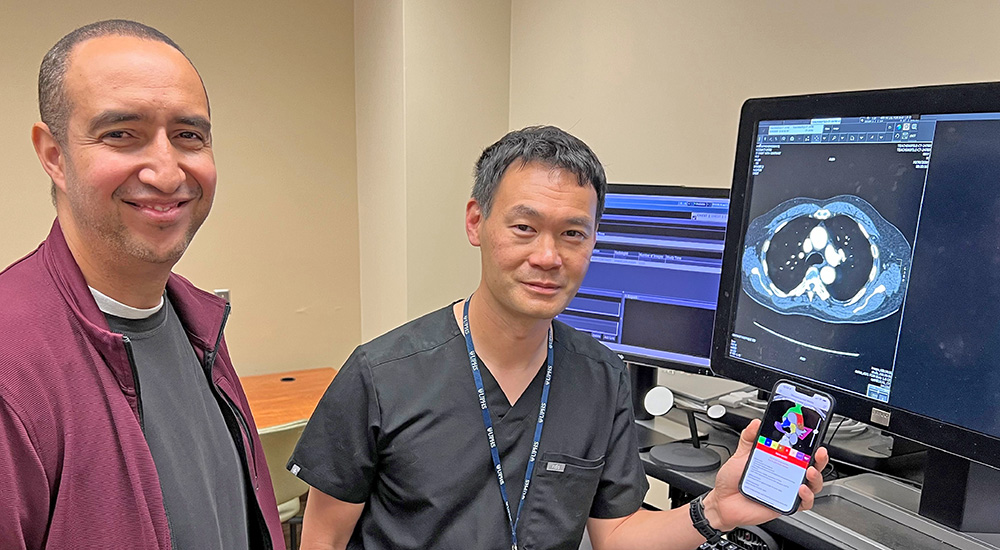Every morning, the halls of Los Angeles VA fill with doctors, nurses and support staff heading to their departments. Half a world away in Zimbabwe, a doctor uses an app on his phone.
With a few taps on the screen, he brings up the latest information so he can make the right decision in treating his patients.
The apps were developed by two innovative VA physicians who took it upon themselves to create RADIOLOGiQ, a free suite of medical iPhone and iPad apps used by doctors and health care professionals around the world.
These apps assist health care providers with decision making on what to do during the interpretation of X-rays and CT scans. The efforts of these two physicians extend from the LA VA medical center to every continent.
Apps have been used 1.25 million times
What inspired them to develop the apps? “Not only did we want to help patients at our hospital, but we wanted to help doctors and patients all around the world,” said Dr. Ahmed El-Sherief, thoracic radiologist.
“We realized that if we could figure out a way to package medical tools as mobile apps, we could help health care providers take better care of their patients,” said Dr. Charles Lau, thoracic radiologist.
Their medical mobile apps are free to the global medical community. The apps have been used over 1.25 million times by more than 370,000 physicians and nurses worldwide.
The need for correct information
Cancer generally spreads through the lymph nodes, particularly lung cancer which kills more people than any other cancer. When a lymph node gets big, doctors begin to suspect the lymph node may have collected cancerous cells.
It’s crucial to name the lymph nodes correctly because it can influence treatment and prognosis. If a lymph node is misnamed, it’s like giving the wrong address.
A few years ago, El-Sherief and Lau were examining scans and reports and realized that some doctors misnamed the lymph nodes. That was because they were not using the most up-to-date medical guidance. El-Sherief and Lau began to explore why.
Apps help standardize interpretation of medical images
The number of guidelines grows every year and are hard to remember. Lau and El-Sherief concluded there needed to be a better way to share the latest medical guidelines. So, they created RADIOLOGiQ to help standardize the interpretation of medical images.
These medical apps provide “evidence-based decision making, increase consistency of clinical care, and reduce health care costs,” said Lau. Today, the RADIOLOGiQ apps help providers manage abnormal lymph nodes in lung cancer patients. They help manage lung nodules discovered on CTs and help manage unexpected findings not only in the lungs but also in the neck, chest and abdomen.
Something simple for a complex subject
“Often, medical subspeciality groups come together to create guidelines and pathways for handling various medical imaging findings,” explained Lau. “The challenge is that these guidelines are usually very complex to follow, tough to memorize, and change frequently.”
It is practically impossible to keep up to date with these guidelines, El-Sherief and Lau explained. Creating a set of apps to be used on the phone or tablet anywhere, anytime, is ideal for solving this challenge. Any doctor around the world can download the free apps and use them.
Creating a mobile app can be time-consuming and require a great amount of computer programming experience. Fortunately, Lau and El-Sherief had already acquired these skills before they became physicians.
Quick, easy… and the people who use it
Medical imaging is something that touches every patient. Whether it’s a chest X-ray, CT or ultrasound, many medical providers depend on imaging exams for patient care. RADIOLOGiQ’s tools help prevent mistakes that can affect patients’ lives.
“For example, in a lung cancer screening, you have a radiologist who reviews the CT scan and then provides a recommendation. The results are then read by a screening nurse navigator who refers it to physician who determines what to do next. All these individuals, I have been told, use our app,” said El-Sherief.
“The apps we developed are free and accessible to all, ensuring the latest information is available to as many medical providers as possible,” said Lau. “I think one of the things that we benefit from is that mobile technology exploded in the last 15 to 20 years which helps do the work for us.”
“We are passionate about serving our Veterans.”
Lau and El-Sherief say VA provides them an opportunity to do what they are passionate about.
“We are passionate about serving our Veterans. We are passionate about teaching the next generation of physicians. And we are passionate about creating innovative impactful solutions for the health care community around the world.”
Topics in this story
More Stories
Study underscores important role COVID vaccination can have in protecting Veterans from infection and reducing long-term health consequences
Columbia VA’s robotic surgery teams completed their 800th robotic surgery and are on schedule to hit 1,000 by the end of the year.
In a decentralized clinical trial, Veterans can participate from their own homes or local VA instead of having to travel to a research site.







A very informative article
Thanks for the information.